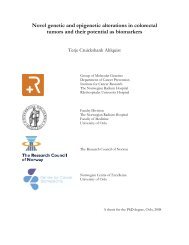Preface - Ous-research.no
Preface - Ous-research.no
Preface - Ous-research.no
You also want an ePaper? Increase the reach of your titles
YUMPU automatically turns print PDFs into web optimized ePapers that Google loves.
Experimental Orthopaedic Research<br />
Leader:<br />
Lars Nordsletten, Professor, MD, PhD, Leader (OC/UiO)<br />
Scietific staff:<br />
Lars Engebretsen Prof MD, PhD (OC/UiO)<br />
Olav Reikerås Prof MD, PhD, (UiO/OUH)<br />
Jan Erik Madsen Prof MD, PhD, (OC/UiO)<br />
Asbjørn Årøen MD, PhD (OC)<br />
Stig Heir MD PhD-Student (Martina Hansens Hospital)<br />
Harald Steen MD, PhD (OUH)<br />
Per Ludvigsen MSc, Engineer (UiO/ OUH)<br />
Sverre Løken MD, PhD (OC)<br />
Ulf W Sigurdsen MD, PhD-Student (UIO/AHUS)<br />
Sigbjørn Dimmen, MD, PhD (LO)<br />
Finn Reinholt Prof MD, PhD (UiO/OUH)<br />
Jan Brinchman Prof MD, PhD (UiO/ OUH)<br />
Stein Erik Utvåg, MD, PhD (AHUS)<br />
Professor Lars Nordsletten<br />
Research area<br />
Joint injuries, diseases and fractures are main reasons for<br />
disability in the community and are often subjected in<br />
younger age groups. It certainly involved large costs for the<br />
society and improved health care in this area would be a<br />
significant improvement both for the individual and the society.<br />
The Experimental Orthopaedic Research group applies<br />
experimental methods on different aspects of orthopaedics,<br />
including <strong>research</strong> on clinical material (biopsies, joint<br />
fluid, and retrievals), animal experiments and cell culture.<br />
Mechanical testing of structures, including live anaesthetized<br />
animals, and materials has been one of the main parts<br />
of our <strong>research</strong> methods. Several of the projects worked on<br />
during the last years were fulfilled with publication or PhD<br />
dissertations during 2010. The experimental work in the<br />
laboratory is close connected to ongoing or clinical studies<br />
under planning for improvement of orthopaedic care of<br />
these patients in the community and the involvments of<br />
the clinicians is one of the strength in the group.<br />
Aims<br />
Develop a <strong>no</strong>vel treatment of focal cartilage defects<br />
Reduce the numbers of deficient fracture healing<br />
Improve healing of tendon grafts in orthopaedic surgery<br />
Delineate the best biomaterial surface for prothesis surgery<br />
CARTILAGE RESEARCH<br />
Malfunction of the knee joint is often associated with<br />
cartilage injury. Whether healing or restoration of lost or<br />
wounded portions of articular cartilage with newly formed<br />
fully functional cartilage is possible remains one of the<br />
unsolved problems in orthopaedic practice. These knee<br />
patients have more problems than patients with rupture of<br />
anterior cruciate ligament rupture and experience severe<br />
limitations in their daily life. Despite this the k<strong>no</strong>wledge<br />
about the best treatment and if surgical treatment do<br />
offer a better outcome than the natural history is still <strong>no</strong>t<br />
documented. A better understanding of articular cartilage<br />
biology, pathophysiology and biomechanics are definitely<br />
warranted. Focused <strong>research</strong> questions in the group, have<br />
been to improve the understanding of the cartilage repair<br />
process and to figure out if mesenchymal stem cells should<br />
be used instead of chondrocytes for cartilage repair. The ongoing<br />
work of the cartilage <strong>research</strong> group can be divided in<br />
three main areas<br />
Experimental cell-culturing cartilage <strong>research</strong><br />
The group has worked intensively providing the best cell<br />
source for cartilage repair. Mesenchymal stem cells harvested<br />
from the bone marrow implanted in hyaluronan-based<br />
scaffold have been intensively studied in the laboratory<br />
for production for production of articular hyaline cartilage<br />
specific markers. Theoretical these cells have a promising<br />
potential for repair of <strong>no</strong>rmal hyaline cartilage. The collaboration<br />
with the Ex Vivo Laboratory (RH) headed by Jan<br />
Brinchmann has improved our ability to be supplied with<br />
improved cells for cell based cartilage repair and to test and<br />
develop new scaffolds (Fig. 1).<br />
Experimental cartilage <strong>research</strong> in an animal model<br />
An important issue in cartilage treatment is the location of<br />
29
















